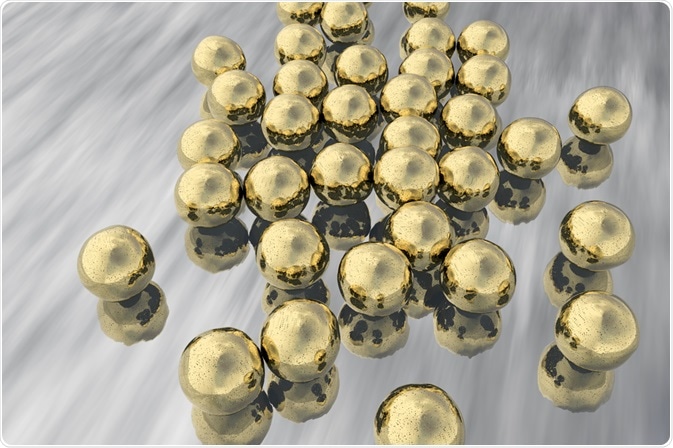Gold Nanoparticle Synthesis
Gold nanoparticles are made up of metallic gold atoms to create a crystal structure of 1-100 nm. Gold nanoparticles have been produced in the laboratory for several decades, and many approaches have since been developed.
 Image Credit: Kateryna Kon / Shutterstock
Image Credit: Kateryna Kon / Shutterstock
Turkevich method
One of the simplest ways is known as the Turkevich method, which uses tetrachloroauric acid (HAuCl4) in combination with trisodium citrate as a reducing and capping agent for the nanoparticles.
During the process Au3+ ions present in solution are quickly reduced to Au+ ions by trisodium citrate, then a disproportionation reaction can occur to generate metallic gold atoms.
These metallic gold atoms then act as nucleation points for the further reduction of Au+ ions in the electron double layer of the atom, allowing the particles to grow from the initial metallic gold nucleus.
Trisodium citrate acts to encourage the deposition of gold onto the initially formed nucleation points, rather than the creation of additional nucleation points, by the gradual increase in pH associated with the creation of AuCl3(OH)– ions occurring over the course of the reaction. AuCl3(OH)– ions are less easily reduced directly to metallic gold than the initial AuCl4– ions which are present at the start of the reaction.
Adjusting the turkevich method
The size and number of nanoparticles created in a reaction can be adjusted by simply altering the reaction conditions and reagents in use.
An initially lower pH ensures a larger proportion of gold precursor in the form of AuCl4– ions, which can be quickly reduced to metallic gold before the pH of the reaction solution begins to rise.
A greater number of metallic gold nucleation points causes the remaining gold in solution to be spread among a greater number of nanoparticles, resulting in particles of a smaller diameter. Temperature, similarly, can affect the number and size of particles generated as low temperatures produce fewer initial nucleation points on which particles grow.
Further modifications to the reaction can be performed, such as the replacement of trisodium citrate with stronger reducing agents to create a greater number of initial nucleation points and thus smaller particles.
Trisodium citrate is frequently still employed as a capping agent, improving the stability of the nanoparticles. However, other chemicals able to coat the nanoparticles can be used such as thiolated polyethylene glycol, which forms a strong covalent Au-S bond.
Anisotropic gold nanoparticles
Spherical gold nanoparticles can be used as seeds upon which further growth can be encouraged or blocked, using a variety of chemicals or biomolecules, along particular crystallographic axes. Uneven growth in each direction such as this is known as anisotropic growth.
Using methods of anisotropic growth, gold nanoparticles can be created in a variety of shapes and sizes, including nanowires, dumbbells, cubes, stars, triangles, plates, cages and several other morphologies.
Each variety of anisotropic gold nanoparticle possesses properties that lend themselves well to particular applications such as catalysis, radiation dose enhancement, drug delivery, electronics, or solar cell enhancement.
Other methods of synthesis
A variety of other methods of producing gold nanoparticles exist, both chemical and non-chemical. These include polymer cages, which induce the growth of particles within a defined space; photosynthesis, where light is used to reduce gold to its metallic form; and biological synthesis, where bacteria, algae, fungi or plants are used to reduce gold to its metallic state through various biological processes.
Some synthesis methods are more appropriate than others depending on the intended application of the gold nanoparticles. Those created for use in an in vivo or in vitro setting must be synthesized with the minimal use of toxic chemicals that would affect results of drug delivery or bioimaging experiments.
Sources:
- Recent trends and methodologies in gold nanoparticle synthesis – A prospective review on drug delivery aspect.
- Missing Piece of the Mechanism of the Turkevich Method: The Critical Role of Citrate Protonation.
- Anisotropic Metal Nanoparticles: Synthesis, Assembly, and Optical Applications.
- Gold Nanoparticles for Physics, Chemistry, and Biology.
- Turkevich in New Robes: Key Questions Answered for the Most Common Gold Nanoparticle Synthesis.
Further Reading
- All Nanoparticle Content
- Nanoparticles – What are Nanoparticles?
- Nanoparticle Uniformity
- Properties of Nanoparticles
- Synthesis of Nanoparticles
Last Updated: Oct 10, 2018

Written by
Michael Greenwood
Michael graduated from Manchester Metropolitan University with a B.Sc. in Chemistry in 2014, where he majored in organic, inorganic, physical and analytical chemistry. He is currently completing a Ph.D. on the design and production of gold nanoparticles able to act as multimodal anticancer agents, being both drug delivery platforms and radiation dose enhancers.
Source: Read Full Article
